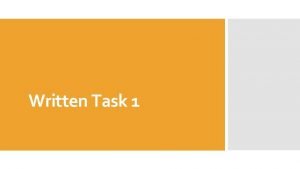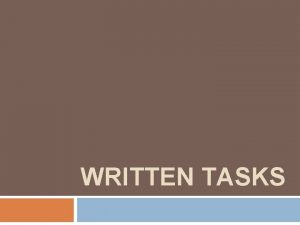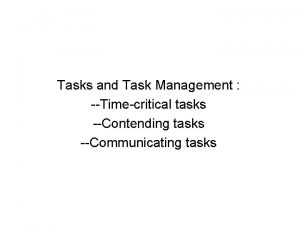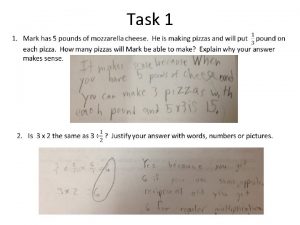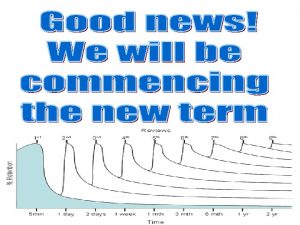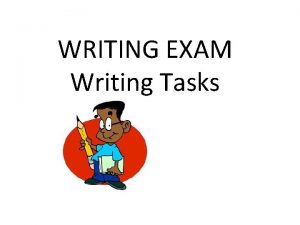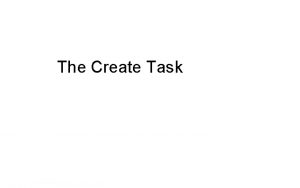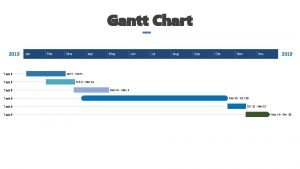Written Tasks What is the Written Task n











- Slides: 11

+ Written Tasks

+ What is the Written Task? n. A task that demonstrates the student’s ability to choose an imaginative way of exploring an aspect of the material studied in the course. It must show a critical engagement with an aspect of a text or a topic.

WT 1: What it is and what it is not + What WT 1 is NOT What WT 1 IS A creative writing assignment: WT 1 is not the opportunity to write a fantastical short story, a hypothetical play script or a cryptic poem. If you want to write a new ending to a novel or a missing chapter, it has to be in the spirit of the author’s intentions. WT 1 is not solely the product of your imagination A type of text: Instead, you have to show that you have understood a ‘text type’. Each text has structural conventions. For example, if you write a speech, it has to have rhetorical devices that are characteristic of speech writing. Be sure that the text type lends itself well to the content you are writing about. Study a few examples of the text type that you want to write. Out of context: It is not enough to state in your rationale, “I’m writing an opinion column about advertising. ” In which magazine or newspaper does your column appear? Is it in the style of a particular columnist? In context: Place your WR 1 in a context. For example, if you want to write an opinion column about advertising, write about a particular ad campaign that has received attention in the news. Imitate the style of a famous columnist. What would he/she say in response to a topic? A persuasive essay: WT 1 is not a test of your opinion. This is not your chance to vent your frustrations about a particular topic that you feel passionate about. An understanding of course work: Instead, WT 1 is a test of the course work. How will you demonstrate your understanding of language and/or literature? Is your written task rooted in a particular text? A summary: Examiners are not interested in reading the summary of a text that you read. This is not a ‘book report’. An interpretation: There should be some evidence of critical thinking. For example, writing a letter from one character to another provides you the chance to show that you’ve understood the work thoroughly.

+ Requirements for the Written Tasks n Standard Level: Complete at least three written tasks, one of which is submitted for external assessment n Higher Level: Complete at least four written tasks, two of which are submitted for external assessment n Teachers may not annotate or edit drafts; we will conference n Students must keep a portfolio of tasks: DO NOT THROW ANYTHING AWAY! n WT 1 is externally assessed for 20% of the final grade

+ Written Task 1 n Must be at 800 -1000 words in length n Accompanied by a 200 -300 word rationale, which precedes the task n The content of task 1 must relate to one of the four parts of the course n Students are free to choose a text type that is appropriate to the content of the task n Written task 1 cannot be a formal essay

+ The Right Ingredients n Text type: If you write a speech, your speech should look and sound like a speech. If you write a letter to the editor, it should look and sound like a letter to the editor. In other words, each type of text has its own set of stylistic and structural conventions. Ask yourself what characteristics define the type of text you plan to write. n Primary source: Your WT should be rooted in a primary source. For parts 3 and 4, the poem, novel or play is the primary source. For parts 1 and 2 (the non-literary parts), you must comment on a primary text. For example, if you look at the representation of women in advertising, comment on an actual ad. If you look at a political campaign, focus on one ad/website/poster.

+ The Right Ingredients (cont’d) n Secondary sources: You are expected to be knowledgeable on the subject matter or literary text. You want to prove to the examiner that you have understood the course work and you have done your homework! Find secondary sources that comment on the texts you have worked on. For example, if you explored women in advertising, you will want to find some statistics or articles on the effects of these ads on women.

+ Common Pitfalls n The WT is not an essay writing assignment. Unfortunately, many ‘opinion columns’ and ‘blogs’ end up sounding like essays n The context of the text is not clear. If you write an opinion column, ask yourself how it is characteristic of an opinion column from a specific newspaper or magazine. Who does it target? n The content of the task has nothing to do with course content. For example, a brochure warning against the health dangers of bulimia does not reflect course work that explored the role of advertising in shaping young women’s sense of beauty.

+ The Rationale n In the rationale students must explain: n how the content of the task is linked to a particular part of the course n how the task is intended to explore particular aspects of the course n the nature of the task chosen n information about audience, purpose and the social, cultural, or historical context in which the task is set n The rationale should not only include knowledge about the text or topic studied, but also about the formal conventions of the text type produced and how they relate to the aims of the task

+ Example Text Types for Written Task 1 n A short story n A public information document n A diary entry n An episode from a literary text rewritten to place the action in another setting n An opinion column n A blog

+ Written Task 2 (HL) n Written task 2 is a formal, analytical essay n Must be 800 -1000 words in length n Accompanied with an outline (NO rationale) n The content of task 2 must relate to one of the four parts of the course (if WT 1 covered a language part, WT 2 must cover a literature part) n There are two prescribed questions for each of the areas of study listed below; students answer ONE of the questions for WT 2: n n n Reader, culture, and text Power and privilege Text and genre

